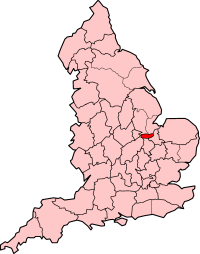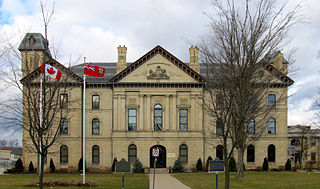In Great Britain and Ireland, a county town is the most important town or city in a county. It is usually the location of administrative or judicial functions within a county, and the place where public representatives are elected to parliament. Following the establishment of county councils in England 1889, the headquarters of the new councils were usually established in the county town of each county; however, the concept of a county town pre-dates these councils.
A grand jury is a jury—a group of citizens—empowered by law to conduct legal proceedings, investigate potential criminal conduct, and determine whether criminal charges should be brought. A grand jury may subpoena physical evidence or a person to testify. A grand jury is separate from the courts, which do not preside over its functioning.
The courts of England and Wales, supported administratively by His Majesty's Courts and Tribunals Service, are the civil and criminal courts responsible for the administration of justice in England and Wales.

A justice of the peace (JP) is a judicial officer of a lower or puisne court, elected or appointed by means of a commission to keep the peace. In past centuries the term commissioner of the peace was often used with the same meaning. Depending on the jurisdiction, such justices dispense summary justice or merely deal with local administrative applications in common law jurisdictions. Justices of the peace are appointed or elected from the citizens of the jurisdiction in which they serve, and are usually not required to have any formal legal education in order to qualify for the office. Some jurisdictions have varying forms of training for JPs.

The Soke of Peterborough is a historic area of England associated with the City and Diocese of Peterborough, but considered part of Northamptonshire. The Soke was also described as the Liberty of Peterborough, or Nassaburgh hundred, and comprised, besides Peterborough, about thirty parishes.
Circuit courts are court systems in several common law jurisdictions. It may refer to:

The Courts Act 1971 is an act of the Parliament of the United Kingdom, the purpose of which was to reform and modernise the courts system of England and Wales.

The Home District was one of four districts of the Province of Quebec created in 1788 in the western reaches of the Montreal District and detached in 1791 to create the new colony of Upper Canada. It was abolished with the adoption of the county system in 1849.

Eastern District was one of four districts of the Province of Quebec created in 1788 in the western reaches of the Montreal District and partitioned in 1791 to create the new colony of Upper Canada.

The District Court of New South Wales is the intermediate court in the judicial hierarchy of the Australian state of New South Wales. It is a trial court and has an appellate jurisdiction. In addition, the Judges of the Court preside over a range of tribunals. In its criminal jurisdiction, the Court may deal with all serious criminal offences except murder, treason and piracy. The Court's civil jurisdiction is generally limited to claims less than A$1,250,000.

Midland District was one of four districts of the Province of Quebec created in 1788 in the western reaches of the Montreal District and partitioned in 1791 to create the new colony of Upper Canada.
A clerk of the peace held an office in England and Wales whose responsibility was the records of the quarter sessions and the framing of presentments and indictments. They had legal training, so that they could advise justices of the peace.

The Courts of Justice Act 1924 was an Act of the Oireachtas that established a new system of courts for the Irish Free State. Among the new courts was the Supreme Court of the Irish Free State, and the first Chief Justice of the Irish Free State was also appointed under the Act.

The courts of assize, or assizes, were periodic courts held around England and Wales until 1972, when together with the quarter sessions they were abolished by the Courts Act 1971 and replaced by a single permanent Crown Court. The assizes exercised both civil and criminal jurisdiction, though most of their work was on the criminal side. The assizes heard the most serious cases, most notably those subject to capital punishment or, later, life imprisonment. Other serious cases were dealt with by the quarter sessions, while the more minor offences were dealt with summarily by justices of the peace in petty sessions.
The courts of assizes or assizes were the higher criminal court in Ireland outside Dublin prior to 1924. They have now been abolished in both jurisdictions.

Montreal District was colonial district in New France and British North America with its capital in Montreal. A descendant of the district exists today as the judicial district of Montreal. Western parts transferred to Upper Canada, later as Canada West and are now in Ontario where as the northeast became Labrador and now within Newfoundland and Labrador.
The palatine courts of Durham were a set of courts that exercised jurisdiction within the County Palatine of Durham. The bishop purchased the wapentake of Sadberge in 1189, and Sadberge's initially separate institutions were eventually merged with those of the County Palatine.
Certain former courts of England and Wales have been abolished or merged into or with other courts, and certain other courts of England and Wales have fallen into disuse.
The justice of the peace was a court official that existed at the county or district level in from the colonial period of the Province of North Carolina until 1968 in the U.S. State of North Carolina. Originally, the Justices of the Peace had authority over the Magistrates Courts, which covered petty criminal offenses and some civil matters. They were appointed by the Governor of the Province. In 1741, they were given the authority to solemnize marriages in counties that did not have ministers or with the consent of the local minister. After North Carolina became a State, they continued authority over Magistrates Courts at the county level, as well as solemnizing of marriages. They were commissioned by Governor of North Carolina upon recommendation of the North Carolina General Assembly. After the U.S. Civil War, they were authorized to register slave marriages that took place before the war. The number of Justices of the Peace in North Carolina continued to grow until the 1950s. The lack of uniform jurisdictions, rules and appointment procedures across North Carolina counties led to major changes in the North Carolina judicial system in 1968 that abolished the Justices of the Peace and placed some of their responsibilities with Magistrates.

Accounts of the Indigenous law governing dispute resolution in the area now called Ontario, Canada, date from the early to mid-17th century. French civil law courts were created in Canada, the colony of New France, in the 17th century, and common law courts were first established in 1764. The territory was then known as the province of Quebec.









